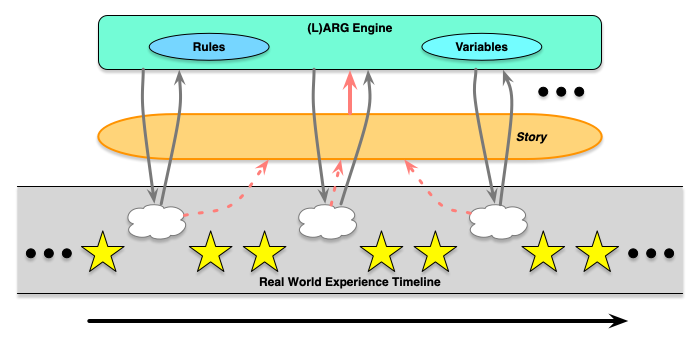The ARG experience
Author: Clark
Go to Source
In preparing a couple of presentation for the Realities 360 conference coming up late this month, I got thinking about ARGs again. ARGs (alternate reality games) were going to be the thing, but some colleagues suggest that the costs were problematic. I still think that ARGs could be powerful learning experiences. And, of course, I understand that the overhead would make them useful only in particular situations. For instance, those where the needs were pressing and the real world experience is important. And I reckon those are few. In some sense, disaster drills are an example! Still, I thought it was worth looking at the ARG experience. And, of course, I made a diagram. It’s nothing particularly astute, but on the principle of ‘show your work’…
In particular, I was thinking about artificial virtuality (AV). In the continuum from reality to virtual reality (VR), AV sits between augmented reality (AR) and VR. That is, the goal is virtual (e.g. a made up one, not one that’s manifest in the real world, at least directly. And yet it permeates the real world. And that, to me, really defines an ARG! Of course, it doesn’t have to be tuned to the experience of a game, it can just be a scenario, but you know I’m not going to stop there! 🙂
 So what’s going on here? I’m suggesting that there’s a story that is the experience designed for the player. I talk about LARGs, which is an ARG for learning. The ARG experience here is implemented by an engine which embodies the game (just as games are done). Instead, however, of the experiences being mediated by a computer interface, instead activities are inserted into the players experience.
So what’s going on here? I’m suggesting that there’s a story that is the experience designed for the player. I talk about LARGs, which is an ARG for learning. The ARG experience here is implemented by an engine which embodies the game (just as games are done). Instead, however, of the experiences being mediated by a computer interface, instead activities are inserted into the players experience.
So, there’s an underlying model driving the action (just as in traditional computer games). There are variables maintaining state, and rules operating on them. So your choice depends on what’s happened before (actions have consequences), and you can be moving up or down depending on how you play. The rules determine what happens next. A colleague built a whole engine for this!
The information and decisions the player takes are mediated by real world interfaces, but distributed, not concentrated in one interface. Videos on a phone, or a screen being passed along the way (e.g. an animated billboard or a TV screen in an office) bring information. Social media is carrying messages.
And the player is similarly sending messages as responses. Even real world objects are instrumented, so a door might lock or unlock as the result of player actions. The player may be choosing between competing taxis. And it can be played out over days. In the example we did, the in-game characters would take overnight to respond to your messages.
Now this could all be done by a puppetmaster (or several), but the goal here would be to set it up so it can run without a suite of people involved. The goal is to design a game like we do traditionally, but manifest across the player’s life. I do recommend seeing the movie The Game as a dramatic example.
The real question is what sort of things match these types of goals. The example we built was for sales training; handling virtual customers. As mentioned above, disaster preparedness could make sense. Or other real world awareness tasks (spies?). Again, there may not be many situations, but for doing that mix of delivering a simulated experience in your life instead of a virtual life could be interesting. Certainly intriguing.
At any rate, I just needed to capture the ARG experience for myself. And to share at the conference. If you’re there, do say hello!
The post The ARG experience appeared first on Learnlets.
